Apache County, Arizona
Apache County is located in the northeast corner of the U.S. state of Arizona. As of the 2010 census its population was 71,518.[1] The county seat is St. Johns.[2]
Apache County | |
|---|---|
 | |
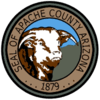 Seal | |
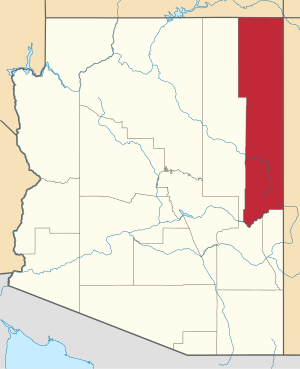 Location within the U.S. state of Arizona | |
 Arizona's location within the U.S. | |
| Coordinates: 35°25′26″N 109°26′33″W | |
| Country | |
| State | |
| Founded | February 24, 1879 |
| Named for | Apache people |
| Seat | St. Johns |
| Largest community | Eagar |
| Area | |
| • Total | 11,218 sq mi (29,050 km2) |
| • Land | 11,198 sq mi (29,000 km2) |
| • Water | 21 sq mi (50 km2) 0.2%% |
| Population (2010) | |
| • Total | 71,518 |
| • Estimate (2019) | 71,887 |
| • Density | 6.4/sq mi (2.5/km2) |
| Time zone | UTC−7 (Mountain) |
| Congressional district | 1st |
| Website | www |
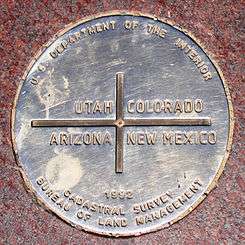
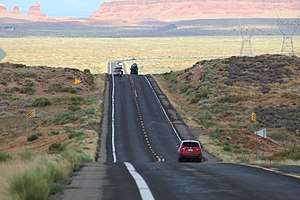
Most of the county forms part of the Navajo Nation and the Fort Apache Indian Reservation, respectively.
History
Apache County was formed during the Tenth Territorial Legislation in 1879 out of the eastern section of Yavapai County; officially all land east of 109°45′ W. By 1895, Navajo County and parts of Graham, Greenlee and Gila Counties were formed from this land. The county seat was placed in the town of Snowflake, but was moved a year later to St. Johns. From 1880 to 1882, the county seat was temporarily in Springerville before being returned to St. Johns.[3]
A history of the area, written in 1896, records the following about the county:
Apache County was created in 1879 and lies in the northeastern corner of the Territory. Until March, 1895, it also embraced what is now Navajo County, but at that date the latter was set apart and established as a separate county. Apache County is justly noted for its great natural resources and advantages. It is destined some day in the early future to have a large agricultural population. Now, immense herds of cattle and flocks of sheep roam over its broad mesas and its fertile valleys. The Navajo Indians occupy the northern part of the county-in fact, occupy much of the remainder of the county, as they refuse to remain on their reservation, preferring to drive their sheep and cattle on lands outside their reservation, where the grazing is better. The southern part is a fine grazing country, while the northern part is cut up into picturesque gorges and canons by the floods of past centuries.[4]
In the late 1880s, the county sheriff was Commodore Perry Owens, an Old West gunfighter legend. At that time, the county covered more than 21,177 square miles (54,850 km2) in territory. In September 1887, near Holbrook in what is now Navajo County, Owens was involved in one of the Old West's most famous gunfights, when he killed three men and wounded a fourth while serving a warrant on outlaw Andy Blevins/Andy Cooper, an active participant in a raging range war, later dubbed the Pleasant Valley War.
In 2015, Apache County had the highest rate of death due to motor vehicles in the United States, with 82.5 deaths per 100,000 people.[5]
The Fort Apache Indian Reservation occupies part of the county.
Geography
According to the U.S. Census Bureau, the county has a total area of 11,218 square miles (29,050 km2), of which 11,198 square miles (29,000 km2) is land and 21 square miles (54 km2) (0.2%) is water.[6] The county is the third-largest county by area in Arizona and the sixth-largest in the United States (excluding boroughs and census areas in Alaska).
Apache County contains parts of the Navajo Indian Reservation, the Fort Apache Indian Reservation, and Petrified Forest National Park. Canyon de Chelly National Monument is entirely within the county.
Adjacent counties
- Greenlee County - south
- Graham County - south
- Navajo County - west
- Montezuma County, Colorado - northeast
- San Juan County, Utah - north
- San Juan County, New Mexico - east
- McKinley County, New Mexico - east
- Cibola County, New Mexico - east
- Catron County, New Mexico - east
Apache County is one of two U.S. counties (the other being Wayne County, West Virginia) to border two counties of the same name, neither of which is in the same state as the county itself (San Juan County, Utah and San Juan County, New Mexico).
Indian reservations
Apache County has the most land designated as Indian reservation of any county in the United States. (Coconino County and Navajo County are a close second and third.) The county has 19,857.34 km2 (7,666.96 sq mi) of reservation territory, or 68.34 percent of its total area. The reservations are, in descending order of area within the county, the Navajo Nation, the Fort Apache Indian Reservation, and the Zuni Indian Reservation, all of which are partly located within the county.
National protected areas
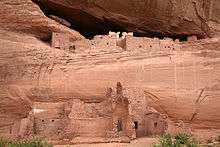
- Apache-Sitgreaves National Forest (part)
- Canyon de Chelly National Monument
- Hubbell Trading Post National Historic Site
- Petrified Forest National Park (part)
Demographics
| Historical population | |||
|---|---|---|---|
| Census | Pop. | %± | |
| 1880 | 5,283 | — | |
| 1890 | 4,281 | −19.0% | |
| 1900 | 8,297 | 93.8% | |
| 1910 | 9,196 | 10.8% | |
| 1920 | 13,196 | 43.5% | |
| 1930 | 17,765 | 34.6% | |
| 1940 | 24,095 | 35.6% | |
| 1950 | 27,767 | 15.2% | |
| 1960 | 30,438 | 9.6% | |
| 1970 | 32,298 | 6.1% | |
| 1980 | 52,108 | 61.3% | |
| 1990 | 61,591 | 18.2% | |
| 2000 | 69,423 | 12.7% | |
| 2010 | 71,518 | 3.0% | |
| Est. 2019 | 71,887 | [7] | 0.5% |
| U.S. Decennial Census[8] 1790–1960[9] 1900–1990[10] 1990–2000[11] 2010–2018[1] | |||
2000 census
As of the census[12] of 2000, there were 69,423 people, 19,971 households, and 15,257 families residing in the county. The population density was 6 people per square mile (2/km²). There were 31,621 housing units at an average density of 3 per square mile (1/km²). The racial makeup of the county was 76.88% Native American, 19.50% White, 0.25% Black or African American, 0.13% Asian, 0.06% Pacific Islander, 1.75% from other races, and 1.43% from two or more races. 4.49% of the population were Hispanic or Latino of any race. 58.39% reported speaking Navajo at home, while 38.39% speak English and 2.71% Spanish .
There were 19,971 households out of which 43.80% had children under the age of 18 living with them, 49.30% were married couples living together, 21.40% had a female householder with no husband present, and 23.60% were non-families. 21.20% of all households were made up of individuals and 6.90% had someone living alone who was 65 years of age or older. The average household size was 3.41 and the average family size was 4.04.
In the county, the population was spread out with 38.50% under the age of 18, 9.40% from 18 to 24, 25.10% from 25 to 44, 18.70% from 45 to 64, and 8.30% who were 65 years of age or older. The median age was 27 years. For every 100 females there were 98.20 males. For every 100 females age 18 and over, there were 94.50 males.
The median income for a household in the county was $23,344, and the median income for a family was $26,315. Males had a median income of $30,182 versus $22,312 for females. The per capita income for the county was $8,986. About 33.50% of families and 37.80% of the population were below the poverty line, including 42.80% of those under age 18 and 36.50% of those age 65 or over. The county's per-capita income makes it one of the poorest counties in the United States.
Apache County is one of only 38 county-level census divisions of the United States where the most spoken language is not English and one of only 3 where it is neither English nor Spanish. 58.32% of the population speak Navajo at home, followed by English at 38.34% and Spanish at 2.72%.
In 2000, the largest denominational group was the Catholics (with 19,965 adherents).[13] The largest religious bodies were The Catholic Church (with 19,965 members) and The Church of Jesus Christ of Latter-day Saints (with 8,947 members).[13]
2010 census
As of the 2010 census, there were 71,518 people, 22,771 households, and 16,331 families residing in the county.[14] The population density was 6.4 inhabitants per square mile (2.5/km2). There were 32,514 housing units at an average density of 2.9 per square mile (1.1/km2).[15] The racial makeup of the county was 72.9% Native American, 23.3% white, 0.3% Asian, 0.2% black or African American, 1.3% from other races, and 2.0% from two or more races. Those of Hispanic or Latino origin made up 5.8% of the population.[14]
The largest ancestry groups were:[16]
- 69.6% Navajo
- 5.4% English
- 5.3% German
- 4.2% Irish
- 4.0% Mexican
- 1.4% American
- 1.1% Scottish
- 1.0% French
- 1.0% Polish
Of the 22,771 households, 42.3% had children under the age of 18 living with them, 42.8% were married couples living together, 21.2% had a female householder with no husband present, 28.3% were non-families, and 24.8% of all households were made up of individuals. The average household size was 3.10 and the average family size was 3.76. The median age was 32.4 years.[14]
The median income for a household in the county was $30,184 and the median income for a family was $36,915. Males had a median income of $38,451 versus $31,557 for females. The per capita income for the county was $12,294. About 26.9% of families and 34.4% of the population were below the poverty line, including 41.8% of those under age 18 and 29.2% of those age 65 or over.[17]
Politics
Owing to its strongly Native American population, Apache County votes solidly Democratic. No Republican presidential nominee has won Apache County since Ronald Reagan in 1980,[18] during an election when incumbent Jimmy Carter was viewed as extremely weak on issues pertaining to the West, especially water development.[19] During most of the 1980s, 1990s and early 2000s Apache was the most Democratic county in Arizona, although concern about Republican immigration policies has led Santa Cruz County to take this title since 2008.
| Year | Republican | Democrat | Others |
|---|---|---|---|
| 2016 | 29.8% 8,240 | 61.8% 17,083 | 8.5% 2,338 |
| 2012 | 31.8% 8,250 | 66.2% 17,147 | 2.0% 520 |
| 2008 | 35.1% 8,551 | 63.2% 15,390 | 1.7% 414 |
| 2004 | 34.7% 8,384 | 64.7% 15,658 | 0.6% 156 |
| 2000 | 30.6% 5,947 | 67.0% 13,025 | 2.5% 484 |
| 1996 | 25.5% 4,761 | 66.3% 12,394 | 8.2% 1,529 |
| 1992 | 25.1% 4,588 | 61.4% 11,218 | 13.4% 2,452 |
| 1988 | 36.8% 5,347 | 61.5% 8,944 | 1.7% 253 |
| 1984 | 43.3% 5,638 | 55.8% 7,277 | 0.9% 117 |
| 1980 | 56.6% 5,991 | 37.0% 3,917 | 6.5% 687 |
| 1976 | 33.4% 3,447 | 63.8% 6,583 | 2.9% 297 |
| 1972 | 50.3% 3,394 | 46.6% 3,145 | 3.1% 211 |
| 1968 | 49.8% 2,092 | 39.7% 1,668 | 10.4% 438 |
| 1964 | 47.5% 1,849 | 52.5% 2,042 | 0.0% 1 |
| 1960 | 51.8% 1,568 | 48.2% 1,459 | 0.1% 3 |
| 1956 | 63.2% 1,685 | 36.8% 981 | 0.0% 1 |
| 1952 | 59.7% 1,767 | 40.3% 1,193 | |
| 1948 | 39.5% 970 | 60.3% 1,480 | 0.2% 5 |
| 1944 | 37.0% 728 | 62.9% 1,238 | 0.1% 2 |
| 1940 | 32.0% 926 | 67.9% 1,969 | 0.1% 3 |
| 1936 | 27.4% 638 | 71.9% 1,674 | 0.6% 15 |
| 1932 | 37.4% 760 | 62.5% 1,271 | 0.2% 3 |
| 1928 | 51.4% 837 | 48.6% 791 | |
| 1924 | 48.5% 620 | 42.9% 548 | 8.6% 110 |
| 1920 | 52.4% 679 | 47.7% 618 | |
| 1916 | 31.7% 311 | 66.1% 648 | 2.1% 21 |
| 1912 | 22.0% 56 | 42.4% 108 | 35.7% 91 |
Education
Primary and secondary schools
The following school districts serve Apache County:
- Alpine Elementary School District
- Chinle Unified School District
- Concho Elementary School District
- Ganado Unified School District
- McNary Elementary School District
- Red Mesa Unified School District
- Round Valley Unified School District
- Sanders Unified School District
- St Johns Unified School District
- Vernon Elementary School District
- Window Rock Unified School District
In addition several other schools, including charter schools and tribal schools operated by the U.S. Bureau of Indian Affairs's Office of Education Programs, serve the county.
Public libraries
The Apache County Library District, headquartered in St. Johns, operates public libraries in the county.[22] The branches include Alpine Public Library (unincorporated area),[23] Concho Public Library (unincorporated area),[24] Greer Memorial Library (unincorporated area),[25] Round Valley Public Library (Eagar),[26] Sanders Public Library (unincorporated area),[27] St. Johns Public Library (St. Johns),[28] and Vernon Public Library (unincorporated area).[29]
The Navajo Nation Museum and Library is located in Window Rock, Arizona. The library and museum is the largest one on the Navajo Nation and in Apache County.
Transportation
Major highways
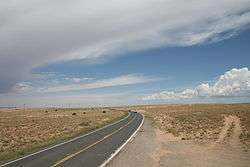
.svg.png)







Airports
The following public use airports are located in Apache County:
- Chinle - Chinle Municipal Airport (E91)
- Springerville - Springerville Municipal Airport (D68)
- St. Johns - St. Johns Industrial Air Park (SJN)
- Window Rock - Window Rock Airport (RQE)
Communities
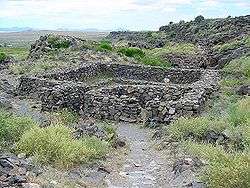
City
- St. Johns (county seat)
Towns
Census-designated places
- Alpine
- Burnside
- Chinle
- Concho
- Cornfields
- Cottonwood
- Del Muerto
- Dennehotso
- Fort Defiance
- Ganado
- Greer
- Houck
- Klagetoh
- Lukachukai
- Lupton
- Many Farms
- McNary
- Nazlini
- Nutrioso
- Oak Springs
- Red Mesa
- Red Rock
- Rock Point
- Rough Rock
- Round Rock
- St. Michaels
- Sanders
- Sawmill
- Sehili
- Steamboat
- Teec Nos Pos
- Toyei
- Tsaile
- Vernon
- Wide Ruins
- Window Rock
Unincorporated communities
County population ranking
The population ranking of the following table is based on the 2010 census of Apache County.[30][31]
† county seat
| Rank | City/Town/etc. | Population (2010 Census) | Municipal type | Incorporated |
|---|---|---|---|---|
| 1 | Eagar | 4,885 | Town | 1948 |
| 2 | Chinle | 4,518 | CDP | |
| 3 | Fort Defiance | 3,624 | CDP | |
| 4 | † St. Johns | 3,480 | City | 1879 |
| 5 | Window Rock | 2,712 | CDP | |
| 6 | Springerville | 1,961 | Town | 1948 |
| 7 | Lukachukai | 1,701 | CDP | |
| 8 | St. Michaels | 1,443 | CDP | |
| 9 | Many Farms | 1,348 | CDP | |
| 10 | Ganado | 1,210 | CDP | |
| 11 | Tsaile | 1,205 | CDP | |
| 12 | Houck | 1,024 | CDP | |
| 13 | Round Rock | 789 | CDP | |
| 14 | Sawmill | 748 | CDP | |
| 15 | Dennehotso | 746 | CDP | |
| 16 | Teec Nos Pos | 730 | CDP | |
| 17 | Rock Point | 642 | CDP | |
| 18 | Sanders | 630 | CDP | |
| 19 | Burnside | 537 | CDP | |
| 20 | McNary | 528 | CDP | |
| 21 | Nazlini | 489 | CDP | |
| 22 | Red Mesa | 480 | CDP | |
| 23 | Rough Rock | 414 | CDP | |
| 24 | Del Muerto | 329 | CDP | |
| 25 | Steamboat | 284 | CDP | |
| 26 | Cornfields | 255 | CDP | |
| 27 | Klagetoh | 242 | CDP | |
| 28 | Cottonwood | 226 | CDP | |
| 29 | Wide Ruins | 176 | CDP | |
| 30 | Red Rock | 169 | CDP | |
| 31 | Alpine | 145 | CDP | |
| 32 | Sehili | 135 | CDP | |
| 33 | Vernon | 122 | CDP | |
| 34 | Oak Springs | 63 | CDP | |
| 35 | Greer | 41 | CDP | |
| 36 | Concho | 38 | CDP | |
| 37 | Nutrioso | 26 | CDP | |
| 38 | Lupton | 25 | CDP | |
| 39 | Toyei | 13 | CDP |
Notable people
- Berard Haile
- Cormac Antram
- Don Lorenzo Hubbell
- Anselm Weber
- Rex E. Lee
- David King Udall
- Mo Udall
- Stewart Udall
- William Cooper
- John Wayne
- Henry Chee Dodge
- Joe Shirley Jr.
- Annie Dodge Wauneka
References
- "State & County QuickFacts". United States Census Bureau. Archived from the original on December 4, 2015. Retrieved May 18, 2014.
- "Find a County". National Association of Counties. Archived from the original on May 31, 2011. Retrieved June 7, 2011.
- Walker, Henry (1986). "Historical Atlas of Arizona", p.32. University of Oklahoma Press, Norman. ISBN 978-0806120249.
- A Historical and Biographical Record of the Territory of Arizona. Chicago: McFarland & Poole. 1896. p. 300.
- "Underlying Cause of Death, 1999-2015 Results". Centers for Disease Control and Prevention. Retrieved January 11, 2017.
- "2010 Census Gazetteer Files". United States Census Bureau. August 23, 2012. Retrieved August 23, 2015.
- "Population and Housing Unit Estimates". Retrieved May 10, 2019.
- "U.S. Decennial Census". United States Census Bureau. Retrieved May 18, 2014.
- "Historical Census Browser". University of Virginia Library. Retrieved May 18, 2014.
- "Population of Counties by Decennial Census: 1900 to 1990". United States Census Bureau. Retrieved May 18, 2014.
- "Census 2000 PHC-T-4. Ranking Tables for Counties: 1990 and 2000" (PDF). United States Census Bureau. Retrieved May 18, 2014.
- "U.S. Census website". United States Census Bureau. Retrieved May 14, 2011.
- "County Membership Reports". thearda.com. Archived from the original on September 25, 2012. Retrieved August 22, 2011.
- "DP-1 Profile of General Population and Housing Characteristics: 2010 Demographic Profile Data". United States Census Bureau. Archived from the original on February 13, 2020. Retrieved January 20, 2016.
- "Population, Housing Units, Area, and Density: 2010 - County". United States Census Bureau. Archived from the original on February 13, 2020. Retrieved January 20, 2016.
- "DP02 SELECTED SOCIAL CHARACTERISTICS IN THE UNITED STATES – 2006-2010 American Community Survey 5-Year Estimates". United States Census Bureau. Archived from the original on February 13, 2020. Retrieved January 20, 2016.
- "DP03 SELECTED ECONOMIC CHARACTERISTICS – 2006-2010 American Community Survey 5-Year Estimates". United States Census Bureau. Archived from the original on February 13, 2020. Retrieved January 20, 2016.
- Sullivan, Robert David; ‘How the Red and Blue Map Evolved Over the Past Century’; America Magazine in The National Catholic Review; June 29, 2016
- Reisner, Marc; Cadillac Desert: The American West and Its Disappearing Water; p. 11 ISBN 0140178244
- "Dave Leip's Atlas of United States Presidential Elections". Retrieved June 11, 2011.
- Scammon, Richard M. (compiler); America at the Polls: A Handbook of Presidential Election Statistics 1920-1964; pp. 42-44 ISBN 0405077114
- "Home Archived January 29, 2011, at the Wayback Machine." Apache County Library District. Retrieved on January 30, 2011. "Apache County Library District PO Box 2760 30 South 2nd West St Johns, AZ 85936"
- "Alpine Public Library Archived August 13, 2010, at the Wayback Machine." Apache County Library District. Retrieved on January 30, 2011.
- "Concho Public Library." Apache County Library District. Retrieved on January 30, 2011.
- "Greer Memorial Library Archived August 22, 2010, at the Wayback Machine." Apache County Library District. Retrieved on January 30, 2011.
- "Round Valley Public Library." Apache County Library District. Retrieved on January 30, 2011.
- "Sanders Public Library." Apache County Library District. Retrieved on January 30, 2011.
- "St. Johns Public Library." Apache County Library District. Retrieved on January 30, 2011.
- "Vernon Public Library." Apache County Library District. Retrieved on January 30, 2011.
- "2010 U.S. Census website". United States Census Bureau. Retrieved December 6, 2015.
- "Archived copy". Archived from the original on December 29, 2014. Retrieved December 7, 2017.CS1 maint: archived copy as title (link)
